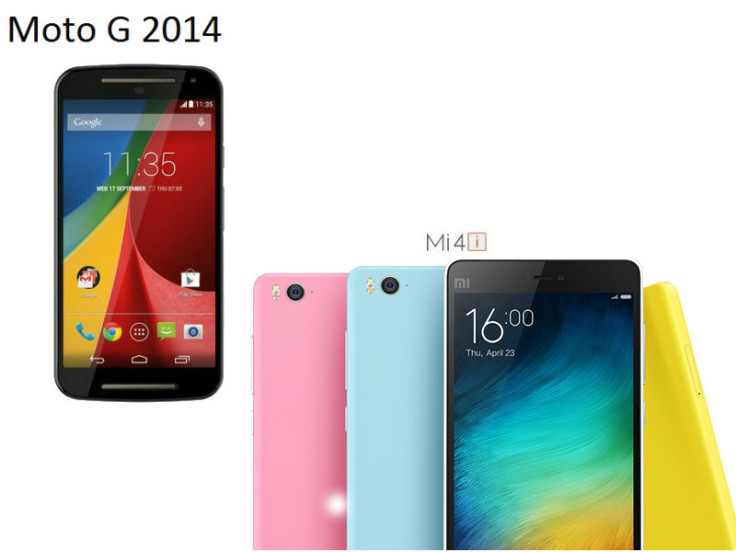Xiaomi Mi 4i vs Motorola Moto G 2014: Which value-for-money smartphone should you buy

Pure mid-range smartphones that provide a comparatively high degree of technical versatility to more than complement their price tags are slowly becoming the rage and are being released extensively by even top brass smartphone manufacturers along with their tier-2 counterparts.
Generally, these value-for-money mid-rangers are targeted at both kinds of users, those who prefer to use their smartphones for office work as well as those who prefer smartphones for general everyday usage.
The years 2014 and 2015 witnessed the release of a large number of handsets that fall in the above category; and predominant among these are the recently released Xiaomi Mi 4i and the second-gen Moto G (aka Moto G 2014).
Both the Xiaomi Mi 4i and Moto G 2014 could leave buyers spoilt for choice with respect to making an informed purchase as these handsets incorporate multiple identical tech-specs and fall into the value-for-money category. Hence, a technical comparison between the Mi 4i and Moto G 2014 gains relevance.
Xiaomi Mi 4i vs Moto G 2014
Display
Both the Xiaomi Mi 4i and Moto G 2014 incorporate an identical 5in display; but the former has resolutions of 1080 x 1920 in comparison to the latter's resolution of 720 x 1280. Even the pixel density in the Mi 4i (approximately 441 pixels per inch) is superior to that of the second-gen Moto G (294 pixels per inch approximately).
With a better pixel density and resolution, sharper and clearer images are formed on the Xiaomi Mi 4i's screen, rather than on the second-gen Moto G's display.
However, Moto G 2014 comes with a Corning Gorilla Glass 3 screen protector and offers an extra layer of glass to prevent scratches/jerks.
On a positive side, both the smartphones support Multitouch and 16 million colours.
It is clearly evident, from the above aspects, as to who the winner is in terms of offering a better display.
Hardware
Xiaomi's Mi 4i has onboard 1.7GHZ quad-core Cortex A53 and 1.1 GHz quad-core Cortex A53 CPUs over a Qualcomm MSM8939 Qualcomm Snapdragon 615 SoC.
On the other hand, Motorola's Moto G 2014 is much inferior in terms of processors, as the smartphone packs in only a 1.2GHz quad-core Cortex-A7 CPU in a Qualcomm MSM8226 Snapdragon 400 SoC.
The Mi 4i is clearly a winner as far as offering a decent computing experience is concerned by virtue of a combined octa-core processor experience over a superior SoC when compared to the Zenfone 2.
Memory
The Xiaomi Mi 4i features 2GB RAM onboard; and this in combination with either of the quad-core SoCs of the smartphone, should allow users to utilise it for a comparatively decent degree of high-end gaming.
The second-gen Moto G features a comparatively inferior (as per today's RAM standards) 1GB RAM which should offer a basic level of high-end gaming for owners of the smartphone.
With respect to internal storage, the Mi 4i gives its users a fixed 16GB default storage area; the Moto G features an 8GB internal storage area by default which can be expanded up to 32GB via an external MicroSD card.
Camera
In terms of serving as a decent instrument of photography (and multimedia), Xiaomi Mi 4i beats the second-gen Moto G hands-down (on paper) with its 13MP primary camera and the 5MP secondary camera, in comparison to the 8MP primary and 2MP secondary cameras found in the Moto G.
However, considering Chinese smartphones do not provide the advertised amount of multimedia technicality, those looking at buying a smartphone that doubles up as an amateur photography aid can choose the second-gen Moto G instead.
Battery
Xiaomi Mi 4i is driven by a 3120 mAh Li-Ion battery that is claimed to offer users a 35-hour talktime when connected to 3G networks.
On the other hand, the Moto G 2014 packs in a comparatively inferior 2070 mAh Li-Ion battery with unknown talktime.
Hence, it is clear as to who the winner in the decent battery backup segment is here.
Software
Xiaomi's Mi 4i, being a recent release enjoys the Android 5.0.2 (Lollipop) privilege along with Xiaomi's newer MiUI 6.0 on top; whereas the Moto G 2014 runs Android 4.4.4 (KitKat) by default but is eligible to receive an upgrade to Lollipop.
Xiaomi Mi 4i, by virtue of its Lollipop experience emerges a clear winner as far as offering decent computing, user interface and a smooth operating experience are concerned.
Release date and price
Currently, Xiaomi Mi 4i is available to purchase only in India, with expansion to other countries expected very shortly. The smartphone costs Rs 13,000 (£135).
The second-gen Moto G being an older release is available all over the world, at an average cost of £145 ($220, Rs 14,000).
Going by the above technical comparison, Xiaomi's latest release emerges a clear winner, but buyers preferring a reliable non-China branded device can still go in for the second-gen Moto G.
© Copyright IBTimes 2025. All rights reserved.





















